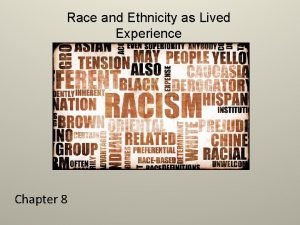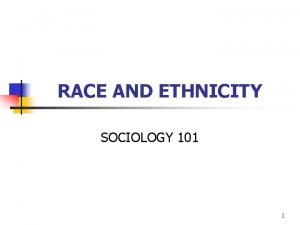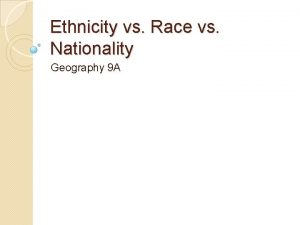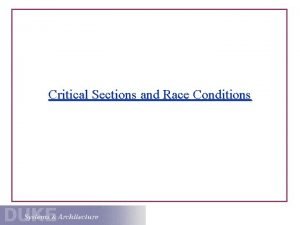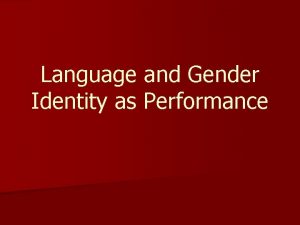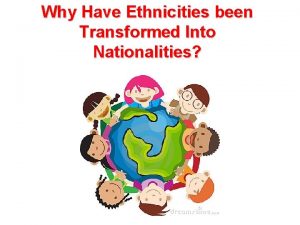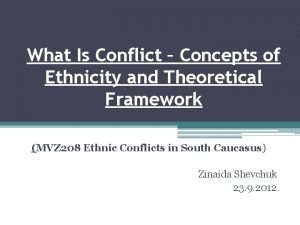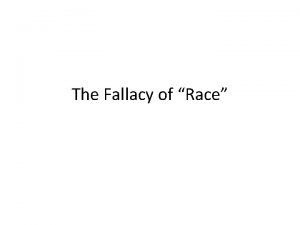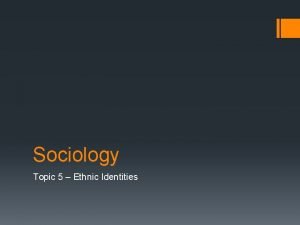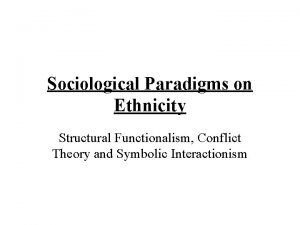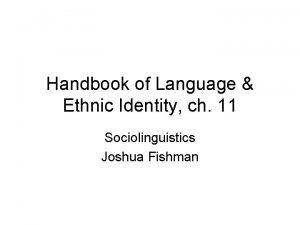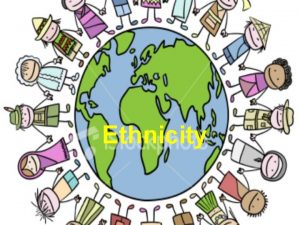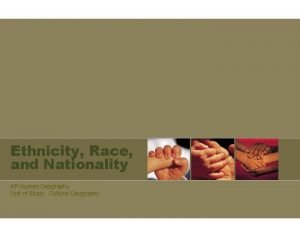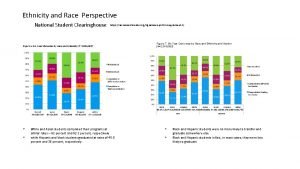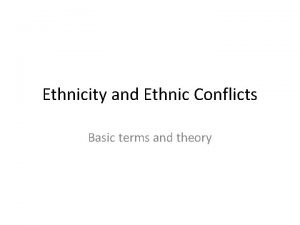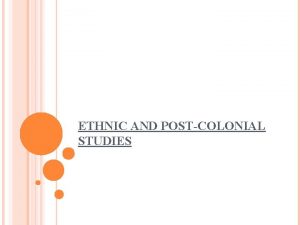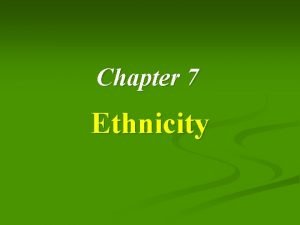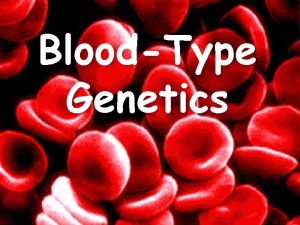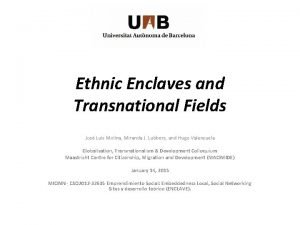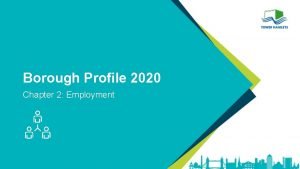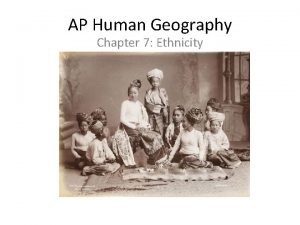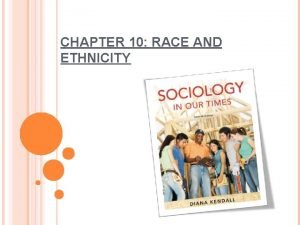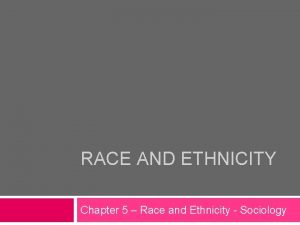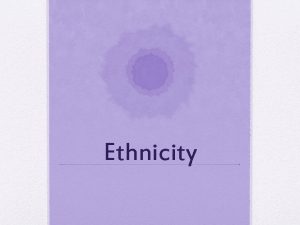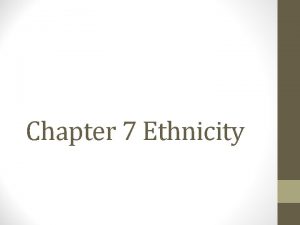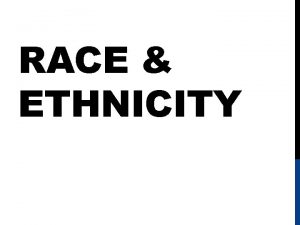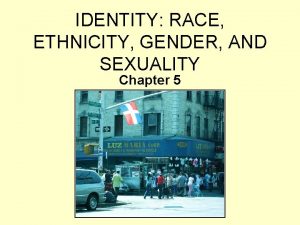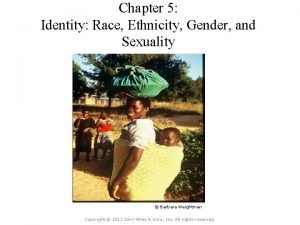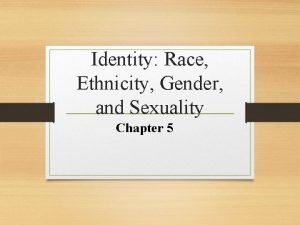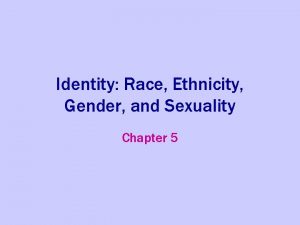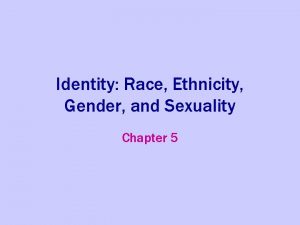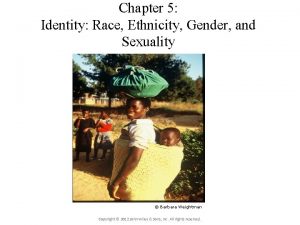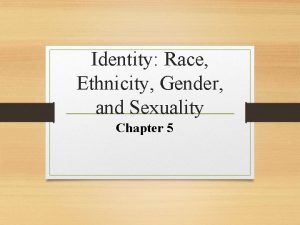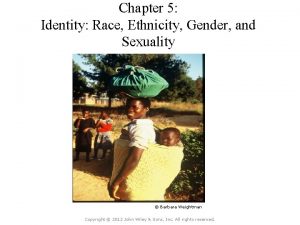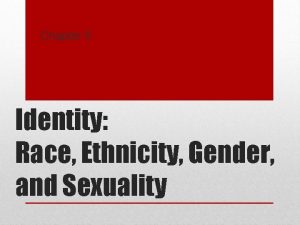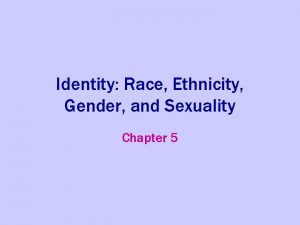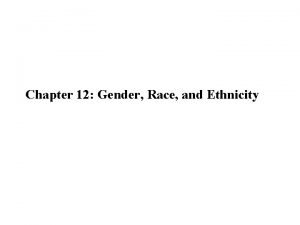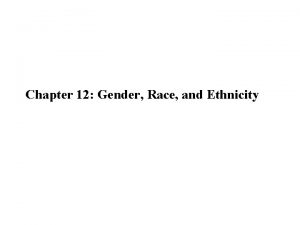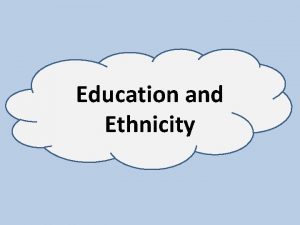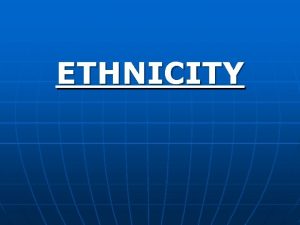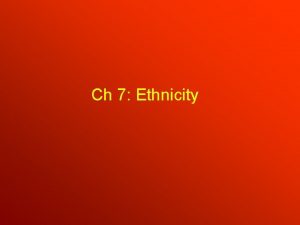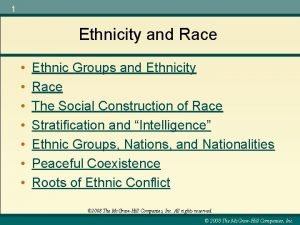Chapter 5 Identity Race Ethnicity and Gender I


































- Slides: 34

Chapter 5 Identity: Race, Ethnicity, and Gender

I. What is Identity, and How are Identities Constructed? • Identity- how we make sense of ourselves – Experiences, emotions, connections, & rejections • Identifying Against- define others to see “what we are not”

Race • Constructed Identity, false assumption – All “races” are biologically the same in the way that humans refer to it • Ideas of race grew out of European Colonialism – Benedict Anderson says socioeconomic classes (wealth) fueled the idea of racial superiority – Europeans used terms such as “savages, mystical, and others” leading to idea of superiority

Gender • Gender – “a culture’s assumptions about the differences between men and women: their ‘characters, ’ the roles they play in society, what they represent. ” - Domosh and Seager

What defines a Race? • Skin color, eye color, hair color? – Each of these are differences WITHIN races, not BETWEEN them • Skin color- Unreliable method of determining race – Sunlight stimulates production of melanin which darkens the skin to protect from UV rays – Dark skin means more melanin – Probably comes from generations of exposure to sun in tropical areas, nothing more

deblij_ch 05_table 01

Racism in the US • Categories of “Race” practiced through: – Residential segregation – Racialized divisions of labor – Categories of “race” recorded by the census bureau • Hispanic is now defined as an ethnicity • White/Hispanic white/non-Hispanic or black/Hispanic black/non-Hispanic

deblij_ch 05_fig 02

deblij_ch 05_table 02

Residential Segregation • “degree to which 2 ore more groups live separately from one another, in different parts of urban environment” • On the decline in the US everywhere & between all groups – Most segregated for African Americans: Milwaukee, Wis. – least segregated is Orange County, Cal. – Most segregated for Asians: San Francisco - least is Sulffolk (NY) & Baltimore MD – Most for Hispanics: New York City - Least is Baltimore, MD • Oklahoma is the least segregated state overall

deblij_ch 05_fig 04

deblij_ch 05_fig 05

II. How Do Places Affect Identity, and How Can We See Identities in Places? • Sense of Place- giving meaning to a place by attaching experiences and memories

Ethnic Patterns and Process • Ethnicity is in many senses as important a category as race • Term ethnic comes from the Greek word ethnos, meaning “people” or “nation” • Racial identity is largely a matter of self-perception • Defining characteristics differ from place to place – – Shared cultural traits Common history Treasured cultural landscape Real or potential threats to language or faith • The Hutu and Tutsi are African peoples who define themselves in terms of cultural history and lifestyle, not race – so this is and ethnic conflict- not a racial one

Ethnic Spaces and Places • In America, ethnic enclaves are common – Have names such as “Chinatown, ” “Little Italy, ” or “Little Havana” etc. – Place names can record the aspirations of some of America’s immigrants – use of the word “new” • Chinatown in Mexicali- map on page 137 shows how Chinese have made huge impact in this town which was primarily Hispanic – Now cultural landscape is primarily Chinese due to businesses • Some immigrants hoped to find comparable or familiar natural environments • Ethnic Islands- certain rural ethnic groups are concentrated in environments similar to their source area • Example- Scandinavians live in Minnesota

deblij_ch 05_fig 09

Advantages of ethnic community – Group identity and cohesiveness – Makes a social network – For the new arrival to the area it eases transition – A familiar language and common church – Preserves and protects customs and traditions to mutual advantage

Ethnic Conflict • Conflict is called “Ethnic” when “Racial” distinction can’t easily be made between conflicting groups • Causes and deterrents – Deterring factors • Achieving independence • Prosperity • Achieving power in government – Causes • Discrimination and lack of political power • Lack of territory • When governments seek to suppress or deny the existence of ethnic minorities

III. How do Power Relationships Subjugate Certain Groups of People? • Inequality of Gender • Economy and productivity – Women’s productivity • Their work is not included in the world’s GNP –It is unpaid –If it was counted, GNP would increase about 30%

deblij_ch 05_fig 12

A woman’s unpaid labor in the periphery (less developed countries) –Produce more than ½ of all the food –Build homes, dig wells, and make clothes –Plant and harvest crops

deblij_ch 05_fig 13

Sub-Saharan Africa Women probably have the hardest life Produce an estimated 70% of the food by hand labor Gather firewood from ever-increasing distances Left many times without a husband who has moved to the city § Cannot get bank loans or title to the land she works § A young girl will start working 12 hours a day as soon as she is able § Cash crops such as tea are called “men’s crops” because the men trade what the women produce § §

Women in the labor force • In the core realms from 35 -39 percent of the labor force – In Sub-Saharan Africa, nearly 80% work in agriculture – In Asia more than 50% work in agriculture • The small number working in manufacturing is rising • Many women engage in home-based economic activities – Tailoring, beer brewing, food preparation, and soap making, etc. – These Informal Activities are often the mainstay of the community • All over the world, women still face job discrimination

Politics and public life • The dominance of males – In the United States, approximately half the voters are women – In the US and Canada, women did not receive full enfranchisement- the right to vote- until 1920 – Male domination of political institutions was well established by 1920 – Not all countries have given women the right to vote – Many countries gave the right for women to vote only recently – The right to vote does not give women political power – In recent years there has been an increase of women in politics • In 2001, 14% of Congress were women – A few national leaders have been women – When women have been in power, their policies tend to emphasize equality, development, and peace

Women in India • Lisa Ling was on OPRAH! in 2004 to discuss India’s gender differences (issues at India’s local scale), taking them to the global scale – Girls are still forced into arranged marriages – Dowry deaths are on the rise • When a bride is killed because the father failed to pay the full dowry • 1985: 999 deaths, 1986: 1786 dead, 1989: 2436 dead, 2001: 7000+ dead

Cont. • Ling interviewed woman- Husband demanded $25, 000, flat screen TV, washing machine, air conditioners, refrigerators, & car • Father didn’t pay b/c husband demanded even more after they were married, husband came to hurt her & she had cell phone to call police & stop this (p. 143 picture) • Federal and state governments created legal aid offices to help women • Family courts to hear domestic cases have been created • Tend to be run by older male judges • Try to force the battered or threatened women back into the family fold • Hindu culture attaches great importance to the family structured

deblij_ch 05_fig 14

Female infanticide in India • Revealed 300, 000 more girls than boys die each year- many are aborted after gender-detection tests • Many thousands of female infants are killed each year • Modern techniques of prenatal gender detection contribute far more to the imbalance between male and female • Laws prohibiting prenatal tests solely to determine sex of a fetus are being violated • Fathers want male children to see the lineage preserved – Oldest son lights funeral pyre – Tradition of dowry makes males valuable even if it is now illegal

Power Relations in Los Angeles • LA- jumped from 4% Hispanic in 1960 to 90+ percent Hispanic in 1990 in some neighborhoods • Barrioization- ethnic succession of a neighborhood from one group to another • Asians seen as “model minority” b/c they are stereotyped as prospering through peaceful means despite harassment, exclusion, and discrimination

deblij_ch 05_fig 15

April 29 -30 th 1992 - LA Riots Occur • 43 dead, 2383 injured, 16, 291 arrested • Property damage over $1 billion dollars! • Media said cause was “not guilty” verdict for white officers beating Rodney King

Geographic Explanation show riots as local reactions to: • Influx of new immigrants – Replacement of ethnic neighborhoods by new ethnic groups • Changing cultural landscape – Housing conditions declining – Scarce public resources

Cont. • Myths such as “model minorities” – Many Koreans targeted during riots • Economic Downturn- loss of many jobs – Manufacturing plants closed in S. Central LA, moving out of city & country – Over 70, 000 jobs lost there in early 1980’s alone! • Police brutality simply topped off these problems to lead to violently vented frustrations
 Chapter 8: race and ethnicity as lived experience
Chapter 8: race and ethnicity as lived experience Assimilation culture
Assimilation culture Race vs ethnicity vs nationality
Race vs ethnicity vs nationality Impulse and reaction turbine
Impulse and reaction turbine Forebay design
Forebay design Strategic gender needs and practical gender needs
Strategic gender needs and practical gender needs Data race vs race condition
Data race vs race condition Gender roles and identity
Gender roles and identity Sexual orientation gender identity
Sexual orientation gender identity Gender identity
Gender identity Gender identity tagalog
Gender identity tagalog Personal identity map
Personal identity map Countries and nationalities
Countries and nationalities Theory of ethnicity
Theory of ethnicity Troian bellisario ethnicity
Troian bellisario ethnicity What is ethnicity
What is ethnicity Structural functionalism concept
Structural functionalism concept Symbolic ethnicity
Symbolic ethnicity Ethnicity in sociolinguistics
Ethnicity in sociolinguistics Lactose intolerance by ethnicity
Lactose intolerance by ethnicity Nationality definition ap human geography
Nationality definition ap human geography Ethnicity examples
Ethnicity examples What is ethnicity
What is ethnicity Ethnicity in postcolonialism
Ethnicity in postcolonialism Multiethnic state definition
Multiethnic state definition Baltic finnic ethnic group
Baltic finnic ethnic group Taylor swift blood type
Taylor swift blood type Porter novelli healthstyles survey
Porter novelli healthstyles survey Blood type gametes
Blood type gametes Bitwit ethnicity
Bitwit ethnicity Is hispanic an ethnicity
Is hispanic an ethnicity Is hispanic an ethnicity
Is hispanic an ethnicity Louis molina ethnicity
Louis molina ethnicity Tower hamlets ethnicity
Tower hamlets ethnicity Ethnic conflict ap human geography
Ethnic conflict ap human geography
